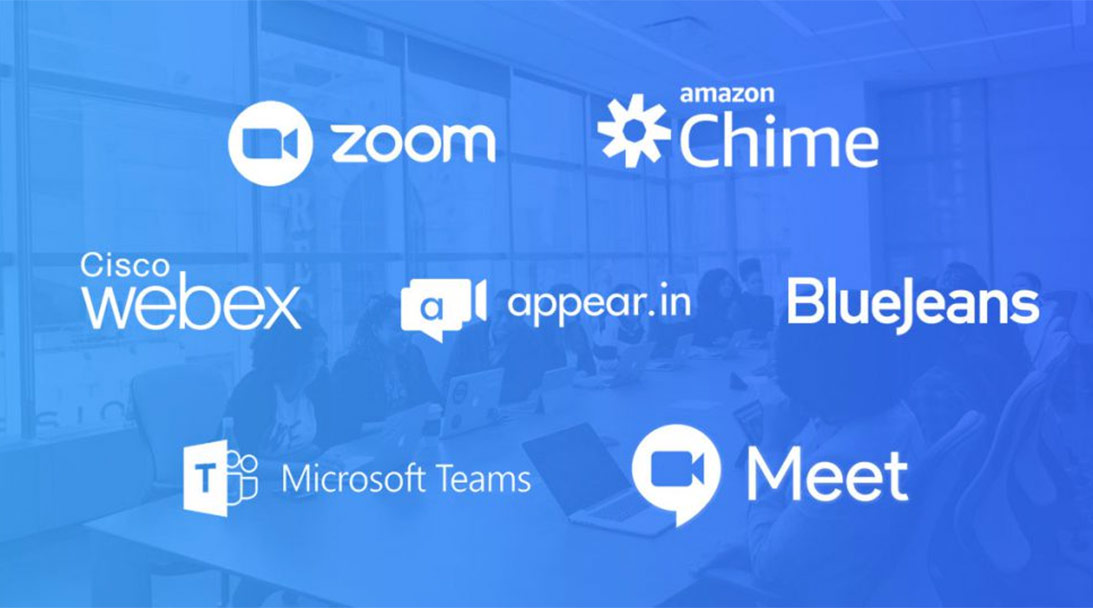For businesses with far-flung offices or remote workers, video conferencing is the next best thing to having everyone together in the same room. But with dozens of choices for video conferencing software, it can be tough to find the one that ticks all the right boxes. We’re here to help with a rundown of the seven best video conferencing software available in 2019.
Video conferencing is convenient but also more resource intensive and a bit more complex than dialing into a phone bridge. No one wants to spend the opening minutes of an important meeting wrestling with technology, or for the software they’re using to conk out mid call – which makes finding easy-to-use, reliable video conferencing software essential.
Asking the right questions
Key criteria when deciding on the best video conferencing software for your business include:
What does it cost?
Most business-grade video conferencing services charge a monthly or yearly subscription fee. Free services, or free versions of paid services, tend to be geared to consumers. But don’t disqualify no-cost options entirely. Depending on the size of your business and your plans for video conferencing, a free service might offer everything you need.
Video conferencing software like Google Hangouts Meet and Microsoft Teams are part of a package of cloud-based services. Consider whether your business could use any other G Suite or Microsoft Office 365 apps and services. If so, and if the capabilities of the bundled video conferencing service hit the mark, it may make sense to subscribe to an integrated suite of services instead.
How many hosts or user licenses does it allow?
If all your business wants is a way for two distant offices to virtually come together, most video conferencing software will do. But if multiple people in your company need to be able to host their own video meetings, a more robust solution – or a higher-priced subscription tier – may be necessary.
How many participants per meeting does it support?
The max number of meeting participants video conferencing services allow ranges from just a few to over a thousand. Take into account the size of your business and your video conferencing plans. If your company wants to live stream meetings or host webinars, for example, you’ll want to limit your search to services that offer ample room for attendees per session.
Does it integrate with any of your other solutions?
You might want to use your video conferencing software with applications like Microsoft Outlook and Apple Mail, streaming services such as YouTube and Facebook Live, or existing video conferencing systems from companies like Polycom and Cisco. Consider what other products and services your company uses and see if the software you’re considering is compatible.
Is there a free trial?
As with any other kind of software, the best way to figure out if a video conferencing solution is right for your business is to try it out yourself. Before you make a decision, see if the solution offers a free trial. Most do.
The best video conferencing software
We reviewed the most popular video conferencing software in 2019 and assessed them based on pricing, features, and video and audio quality.
All pricing details were accurate at the time of writing. Please check each source for the most up-to-date prices.
Microsoft Teams
Part of Microsoft’s Office 365 suite, Microsoft Teams is the successor to Skype for Business. It includes all the same features as that well-known service along with several others, such as the ability to host live and on-demand events for up to 10,000 viewers.

Pricing works much the same way as Hangouts Meet: Microsoft Teams comes packaged with Office 365 subscriptions, which gives you access to a host of other Microsoft apps and services. This makes Teams an attractive choice if your business is subscribed to Office 365 to access workplace standards like Office, PowerPoint and Excel. There’s also a free version of Teams with a fairly generous feature set that includes support for up to 300 meeting attendees. At least an Office 365 Business Essentials or Business Premium plan is required to schedule and record meetings, however.

Going beyond collaboration at Microsoft
Learn how Microsoft used Epiphan Connect to elevate its all-hands event into an engaging video experience.
Watch the videoPros
- Included with Microsoft Office 365 Business Essentials and Business Premium plans
- Free version supports up to 300 meeting attendees
- Host live and on-demand events for up to 10,000 viewers
- Compatible with SIP/H.323 equipment
Cons
- Meeting scheduling and recording limited to paid plans
Bottom line: Teams is an excellent option for Microsoft Office 365 subscribers – and the free version is worth any business’s time to check out.
Amazon Chime
Among Amazon’s suite of cloud computing services is Amazon Chime, a communications service with video conferencing capabilities. Chime delivers high-quality video and wideband audio through a clean, simple-to-use interface. It’s compatible with most Session Initiation Protocol (SIP) and H.323 video conferencing equipment, which means you shouldn’t run into any problems pairing it with your existing system.

Chime may be a natural choice if your company’s workflow includes one or more other Amazon Web Services (AWS). Like any cloud-based service, there’s nothing to deploy or manage with Chime: simply log into your AWS account and you’re ready to start conferencing. Each Chime meeting room can hold up to 100 participants, with video conferencing slots for up to 16 people on desktops and up to eight on mobile devices.
What sets Chime apart from similar solutions is its usage-based pricing. Chime offers a handful of Basic features free of charge: one-to-one video calling, screen sharing, and chat with other Chime users, along with the ability to attend meetings. The cost comes when you use any of Chime’s Pro features, which include the ability to schedule, host and record meetings, and to use the service with conference room video systems. Chime’s pay-as-you-go rate is $3 per user per day up to $15 per user per month. For example, if just one user hosts two meetings in one month without touching any other Pro features, your company’s Chime charges would amount to $6.
Pros
- High-quality video, wideband audio
- Unique, prorated pricing structure for Pro features
- Straightforward interface
- Compatible with SIP/H.323 equipment
- Part of Amazon Web Services suite
Cons
- Less name recognition than competing video conferencing solutions
- Can’t share your screen on mobile devices
Bottom line: Chime’s unique pay-as-you-go pricing structure makes it a good option if your video conferencing needs vary month by month.
appear.in
The team behind appear.in set out to make video conferencing simple. They’ve done a fine job of it. Meetings are easy to set up and even easier to join: no download or login required. Just share the permanent link assigned to your room with attendees and meet there at the agreed time.

When it comes to pricing, appear.in offers three tiers to suit different needs. These include a free version that permits one meeting room for up to four participants along with screen sharing and room locking. Pro is the next step up at $9.99 per month and grants three meeting rooms (max 12 participants each), which you can brand with a custom logo and background. You can add on the ability to record meetings for $5 more. Business is the highest tier and is made up of three sub-tiers to suit companies of various sizes. Starting at $99.99 per month, these include small (15 users, 10 team rooms), medium (30 users, 20 team rooms), and large (50+ users, 20+ team rooms). Each user on a Business plan gets their own personal virtual meeting room plus access to the company’s team rooms, which they can book and share with their colleagues.
Pros
- Simplified video conferencing interface
- Participants don’t need to download anything or log in
- Intuitive scheduling approach based on persistent rooms rather than one-use links
Cons
- Max 12 participants per room, fewer than competing solutions
- Meeting recording only included in highest tier; $5 add-on to Pro tier
Bottom line: Simplicity makes appear.in a good option for businesses who want hassle-free video conferencing for smaller-scale meetings with colleagues, customers, clients, or partners.
BlueJeans Meetings
If the audio quality of your video conferences is paramount, BlueJeans may be the service you’re looking for. BlueJeans uses Dolby Voice technology to reduce background noise and dynamically scales decibel levels to suit different speaker volumes. It also provides spatial audio, which makes it sound like each participant’s voice is coming from somewhere else. Apart from impressive audio, BlueJeans delivers standard video conferencing features like screen sharing and meeting recording.

BlueJeans offers three different service plans. At $12.49 per month, the “Me” tier supports meetings of up to 50 participants and lets users connect from any desktop, iOS or Android device. At $16.65 a month, “My team” allows 75 participants per meeting, meeting recording to the cloud (up to 10 hours per host), and grants access to the BlueJeans Command Center dashboard, which offers an at-a-glance look at service usage and other data. “My company” (variable pricing) is the highest tier, allowing up to 150 participants, compatibility with H.323 and SIP conference room systems, IP VPN (MPLS) integration, and custom branding.
Pros
- Dolby Voice offers superb audio quality
- Supports up to 150 participants (25 video feeds)
- Intuitive scheduling approach based on persistent rooms rather than one-use links
- Facebook Live integration
- Compatible with SIP/H.323 equipment
Cons
- No file sharing
- No free version
Bottom line: BlueJeans delivers high-quality video and impressive audio that’s perfect for businesses whose presentation is prime.
Google Hangouts Meet
If you have a Google Account, chances are you’ve used Google Hangouts. You may have even used it to place a video call. While it bears the Google Hangouts branding, Hangouts Meet is different – built for scheduled video meetings rather than one-to-one video chats. The scheduling process is simple enough. Users can book appointments through the service or via Google Calendar, then visit the Meet homepage at the set time to join.

Hangouts Meet is a compelling choice companies already invested in Google’s G Suite family of services, which includes the likes of Gmail and Google Drive. Unlike plain-old Hangouts, Meet isn’t free (outside of a 14-day trial period): it requires G Suite subscription to use. As a G Suite service, Hangouts Meets can be yours as part of any G Suite subscription plan: Basic ($6 per user per month), Business ($12 per user per month), or Enterprise (variable). Higher tier levels increase numbers of participants – from 25 to 50 to 100. An Enterprise G Suite subscription adds the ability to record meetings to Google Drive and live stream up to 100,000 attendees.
Pros
- Bundled with G Suite subscriptions
- Integrated with popular cloud-based apps like Gmail, Google Drive, and Google Calendar
- Compatible with SIP/H.323 equipment
Cons
- Light on features compared to competing video conferencing solutions
- Only 25 participants per room at the lowest pricing tier
- No screen sharing on mobile devices
Bottom line: Hangouts Meet is a compelling choice for businesses who have need for or already use other Google G Suite services.
WebEx Meetings
WebEx is one of the best-known names in video conferencing. Its simplicity is probably a big reason why. Whether you’re hosting or joining, WebEx makes it easy to get some face-to-face time with colleagues, customers and whoever else matters to your business.

WebEx Meetings delivers high-definition video and audio, features customizable layouts, and allows screen sharing from computers and mobile devices. Users can connect to meetings via desktop, mobile devices, and video conferencing systems. It also includes a handy recording feature that automatically emails participants an MP4 recording of the meeting. Integration with Facebook Live makes it possible to share meetings with or host webinars for up to 100,000 people.
There are four service plans to choose from: Starter ($14.95 per month), Plus ($19.95 per month), Business ($29.95 per month), and an Enterprise level with variable pricing. Plans vary by max number of participants per meeting, number of host licenses, and amount of cloud storage. There is a free option, but it only allows up to three participants per meeting.
Pros
- Easy to schedule and join meetings
- Video recording automatically emails file to participants
- Customizable layouts
- Screen sharing from computers and mobile devices
- Compatible with SIP/H.323 equipment
Cons
- Free plan limited to three participants per meeting
Bottom line: WebEx is widespread and easy to use, which makes it a worthy video conferencing solution for most businesses.
Zoom
Like Microsoft Teams, Zoom boasts an impressive free version that might be all your business needs. At no cost, Zoom lets you schedule and host meetings for up to 100 attendees with up to 25 video feeds per screen and packs in screen sharing, annotation, white boards, session recording, text-based chat, and other features. There’s even the option to divide meetings into “breakout rooms” for periodic, small-scale collaboration.

The main limitation – and possibly a deal breaker for your business – is the 40-minute limit Zoom imposes on free meetings with three or more attendees. Still, Zoom is powerful enough that its paid options are worth looking into. There are three tiers beyond free: Pro ($14.99 per month per host), Business ($19.99 per month per host), and Enterprise ($19.99 per month per host). Higher tiers offer more hosts and max participants (up to 1,000) along with additional features. You can also purchase add-on packages to unlock more participants, cloud storage, and other options.
Pros
- Lots of features – even in the free version
- Meetings support up to 1,000 attendees (with up to 49 video feeds per screen)
- Compatible with SIP/H.323 equipment
Cons
- Free version limits meetings with three or more participants to 40 minutes
Bottom line: Zoom’s feature-rich free version may offer all your business needs. If it doesn’t, a paid plan is worth considering to lift the 40-minute time limit and access features like user management and recording to the cloud.
The key to high-quality video conferencing
Reliable video conferencing software is just one factor when it comes to video meeting quality. The camera you’re using and your audio set up are just as important. Most video conferencing services can deliver high-resolution video and audio, but you’ll only get so much quality out of subpar equipment.
Video conferencing software tend to rely on webcams. But webcams are limiting in terms of quality and give you less control for framing a great image. If you’d like to improve the look and sound of your video conferences, consider using a professional camera. You’ll likely need a capture card to bring the footage into your video conferencing software.
Want to take the quality of your video conferencing even further? Add a video encoder. Epiphan’s Pearl Mini supports multiple cameras and professional audio, and has a built-in touch screen. With the included video switcher, you can quickly swap between a meeting room camera and a presentation playing on a laptop or other device, for example.
Have a look through our products to find one that fits your needs. Questions? Let us know!

Great article, but unclear how Epiphan Pearl Mini could be used to switch a livestream to Microsoft Teams, for instance. I sent an email to tech support for details.